Smart homes demand high-quality, focused light. Yet, many fixtures are bulky or inefficient, clashing with modern design. COB LED downlights provide a sleek, powerful, and smart lighting solution.
COB LED downlights are popular in smart homes because they provide a single, intense beam of light perfect for creating focused scenes and highlighting features. Their compact design integrates seamlessly with modern aesthetics and smart control systems for enhanced functionality.
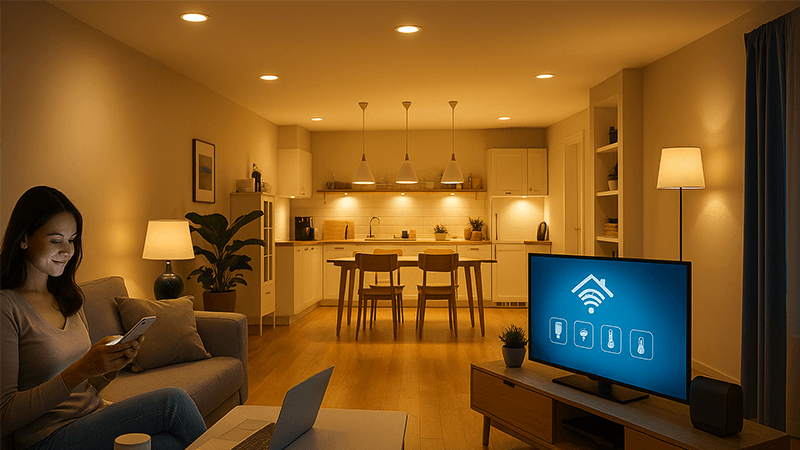
I have spent my entire career in the LED lighting industry, from working on the factory floor to building my own manufacturing business. I have seen technologies come and go. The current shift towards COB LEDs in smart homes1 is not just a trend; it is a significant evolution in how we use light. Clients I work with, like experienced purchasing managers such as Shaz in the UAE, are no longer just buying a light source. They are buying an experience, and COB is central to delivering that. Let's explore why this technology is becoming the new standard.
Why is COB LED better?
You need bright, uniform light that feels natural, not harsh. But older LED technologies can create spotty light or fail unexpectedly. COB technology packs more power into a smaller, more reliable source.
COB (Chip on Board) is better because it mounts many LED chips directly onto a single base. This creates a denser, more intense light with much better heat management2 and a more uniform look compared to older SMD (Surface Mounted Device) LEDs.
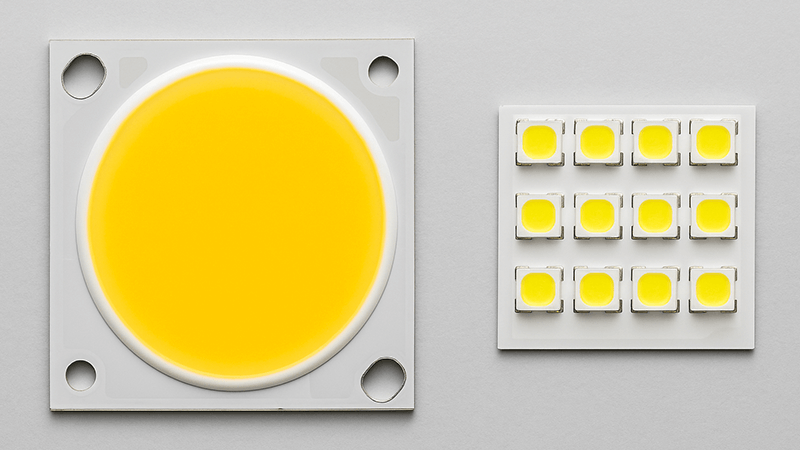
When I started my factory, a major part of our work was helping clients understand the real-world differences between lighting types. The question of COB versus SMD comes up often. On the surface, they are both LEDs, but how they are built changes everything. SMD technology3 places individual LED chips on a circuit board. This is fine for some applications, but it creates multiple shadows and can look like a collection of dots rather than a single, clean light source. COB solves this problem. It bonds the raw LED chips directly to a substrate, creating what looks like a single, large glowing panel.
COB vs. SMD: A Quick Comparison
To make it simple, here is a breakdown of the key advantages that I have seen firsthand. This is the kind of information that helps purchasing managers4 make better sourcing decisions.
| Feature | COB (Chip on Board) LED | SMD (Surface Mounted Device) LED |
|---|---|---|
| Light Appearance | Single, uniform, and focused beam. No multiple spots. | Multiple light points, can create multiple shadows. |
| Light Density | Very high. More lumens from a smaller area. | Lower light density. |
| Heat Management | Superior. Heat transfers directly to a heat sink. | Less efficient. Heat must travel through more layers. |
| Reliability | Higher. Fewer soldering points means fewer failures. | More points of failure due to individual chips. |
The Hidden Factor: Material Quality and Longevity
The real test of a COB LED is not how it looks on day one, but how it performs after 5,000 or 10,000 hours. A critical detail that many overlook is the quality of the encapsulation gel5 that covers the chips. In my experience, this is where many manufacturers cut corners. A low-quality gel will start to yellow over time due to heat. We had a case years ago where a batch from a new supplier looked perfect initially. After six months in the field, we got complaints that the light was turning dull and yellow. We discovered the encapsulation gel's yellowing rate was over 20% after just 5,000 hours. This completely ruined the light's Color Rendering Index (CRI)6. For a smart home where you want to show off true colors, this is unacceptable. A good quality COB should have a yellowing rate of less than 10% over 5,000 hours. This is a technical question I always advise clients to ask their suppliers. It separates the quality manufacturers from the rest.
When did LED lights become a trend?
Lighting trends seem to appear overnight. It can be hard to tell if a new technology is just a short-lived fad or the actual future. Understanding the history of LEDs shows exactly why they are here to stay.
LEDs started becoming a major trend in the late 2000s and early 2010s. This was thanks to the invention of the efficient blue LED, which finally made white light possible, combined with rising energy costs7 and global government programs to phase-out old incandescent bulbs.
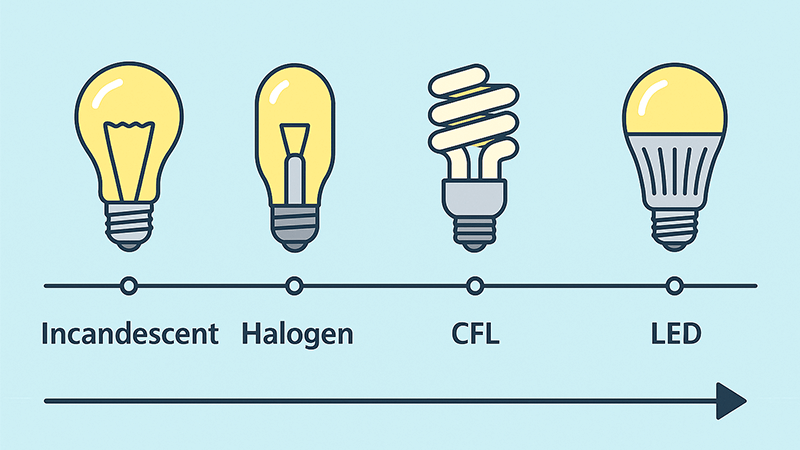
I remember when the industry was all about halogen and fluorescent lights. LEDs existed, but they were mostly small red or green indicator lights on electronics. They were not seen as a serious source for general illumination. Two major events changed everything and pushed LEDs into the mainstream. It was a combination of a scientific breakthrough and market pressure.
The Blue LED Breakthrough
The first LEDs in the 1960s were red. We eventually got other colors, but the one that eluded scientists for decades was a bright, stable blue LED. Without blue, you cannot create pure white light. In the early 1990s, three Japanese scientists—Isamu Akasaki, Hiroshi Amano, and Shuji Nakamura—finally invented the efficient blue LED. This was the missing piece of the puzzle. By coating a blue LED with yellow phosphor, we could suddenly produce high-quality white light. This invention was so important that they won the Nobel Prize in Physics8 in 2014. It was the technological spark that started the entire LED lighting revolution. It opened the door for companies like mine to start developing real lighting products.
The Push from Governments and Markets
The technology was ready, but the market needed a push. This came in the mid-2000s. Energy prices were rising, and governments around the world were looking for ways to improve energy efficiency9. In 2007, the United States passed the Energy Independence and Security Act, which set strict efficiency standards that old incandescent bulbs10 could not meet. Many other countries followed with similar phase-outs. This created a huge market demand for an alternative. At first, CFLs (Compact Fluorescent Lamps) filled some of the gap, but consumers disliked their slow start-up time and poor light quality. LEDs were the perfect solution. I remember when a single LED bulb cost over $30. It was a tough sell. My focus at the factory became finding ways to improve our processes to bring costs down without sacrificing our quality standards. As manufacturing scaled up globally, prices dropped dramatically, and LEDs went from a niche product to the dominant technology on the shelf. This mix of innovation and regulation is what made LEDs a lasting trend.
What is the future of LEDs?
You need to stay ahead of the latest lighting innovations. Investing in technology that will be outdated in a few years is a costly mistake for any project. The future of LEDs is about more than just light; it is about intelligence.
The future of LEDs is intelligent and human-centric. Expect deeper integration with IoT devices, tunable white light11 that mimics natural daylight, and even bigger gains in energy efficiency. Lighting is becoming a core part of a building's data and wellness system.
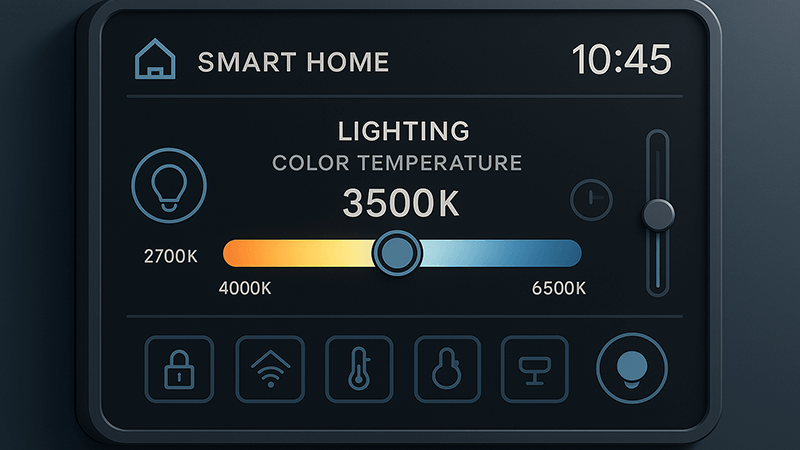
As a manufacturer, I spend a lot of time thinking about what is next. We are constantly experimenting with new technologies because my clients rely on me to provide products that will keep them competitive. The LED is no longer just a simple light source. It is a digital device with immense potential. The future is not just about making lights brighter or more efficient; it is about making them smarter and more beneficial to our health. The conversations I have with contractors and distributors are now focused on features that go beyond simple illumination.
Beyond Illumination: Human-Centric Lighting
One of the most exciting areas is human-centric lighting. This is the idea that artificial light can and should support our natural body clock, or circadian rhythm. The technology behind this is called "tunable white." It uses LEDs that can change their color temperature throughout the day. For example, a downlight can produce a cool, blue-toned light in the morning to help you wake up and be productive. In the evening, it can shift to a very warm, amber-colored light to help you relax and prepare for sleep. This is now possible with advanced COB modules and smart controls. For projects like offices, schools, and high-end homes, this is becoming a must-have feature. It turns lighting from a utility into a wellness tool12.
The Rise of Li-Fi
Another future-forward technology is Li-Fi13, or Light Fidelity. This is the concept of using visible light from LEDs to transmit data, much like Wi-Fi uses radio waves. Every LED light could potentially become a secure, high-speed wireless access point. While it is still a developing technology, the potential is huge, especially in environments where Wi-Fi security is a concern, like hospitals or financial institutions. We are already looking at prototypes in our R&D department. The idea that your downlight could also provide your internet connection might sound like science fiction, but it is closer than you think. It shows how the simple LED is evolving into a complex piece of technology infrastructure.
Why are LEDs becoming so popular?
Everyone talks about LEDs, but knowing the real reasons for their success is key. Missing these core benefits can lead to poor purchasing decisions. Their popularity rests on three main pillars: efficiency, lifespan, and design flexibility14.
LEDs are so popular because they are incredibly energy-efficient, often using 85% less energy than old bulbs. They also last up to 25 times longer and give designers total freedom to create compact and innovative fixtures that were never possible before.
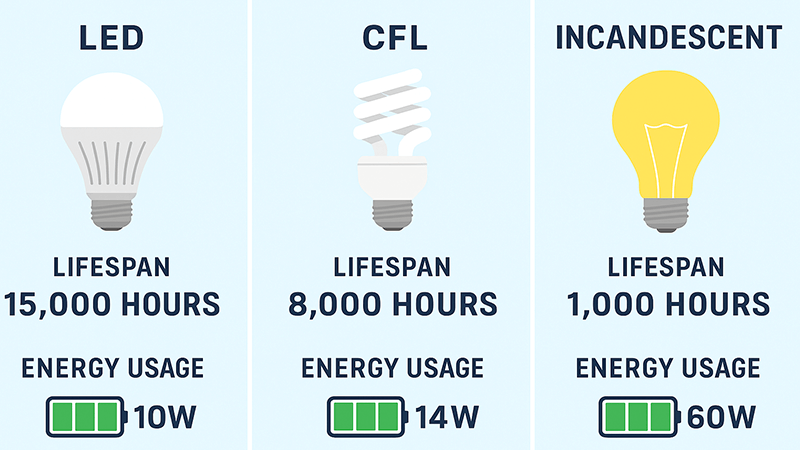
The rapid adoption of LEDs is not an accident. It is based on clear, measurable advantages that benefit everyone from the homeowner to the large-scale project contractor. When I talk to clients, these are the three benefits that always seal the deal. They solve practical, real-world problems better than any lighting technology that has come before. Let's break down these core advantages with some real numbers.
Unbeatable Energy Savings
The most obvious benefit of LEDs is the massive reduction in energy consumption. This is a simple calculation that has a huge impact on operating costs. For example, a single 10-watt COB LED downlight can easily replace an old 75-watt halogen bulb while providing the same amount of light. Now, scale that up. I worked with a hotel project contractor in Dubai who was retrofitting 500 guest rooms. By switching from halogen to LED, the hotel saved thousands of dollars on its electricity bill every single month. For a project purchasing manager like Shaz, presenting these long-term operational savings is often the deciding factor that helps win the contract. The payback period for upgrading to LED is often less than two years.
A Radically Longer Lifespan
The second major pillar is lifespan. A typical incandescent bulb lasts about 1,000 hours. A halogen might last 2,000. A good quality LED, on the other hand, is often rated for 50,000 hours. It is important to understand what that number means. It is not when the bulb burns out. It is a rating called "L70," which is the point where the LED has faded to 70% of its original brightness. In practical terms, an LED used for 8 hours a day can last for over 17 years. This is a game-changer for maintenance costs. For commercial spaces like retail stores, airports, or offices, replacing bulbs is a constant expense that involves labor and equipment. With LEDs, you install them and forget about them for years. This reliability is a huge selling point.
Freedom for Designers
Finally, LEDs have completely changed lighting design. Because LEDs are so small, especially COB chips, they allow for fixture designs that were physically impossible before. Old bulbs were big and produced a lot of heat, which meant fixtures had to be large and bulky to manage them. LEDs are cool and compact. This has given architects and interior designers the freedom to integrate light directly into architecture in new and creative ways. COB LED downlights15 can have very small apertures, creating a clean, minimalist look on the ceiling that is perfect for modern smart homes. Light can now come from tiny, almost invisible sources, putting the focus on the space itself, not on the fixture.
Conclusion
COB LED downlights offer the perfect mix of efficiency, quality light, and smart design. They are a powerful tool for creating modern, intelligent, and beautiful spaces in today's smart homes.
Explore the integration of advanced lighting solutions in modern smart homes. ↩
Understand the importance of heat management in ensuring LED longevity and efficiency. ↩
Understand the key differences between COB and SMD technologies for better lighting choices. ↩
Understand the criteria that purchasing managers consider when sourcing lighting products. ↩
Learn how encapsulation gel affects the durability and quality of LED lights. ↩
Learn how CRI impacts the quality of light and color accuracy in spaces. ↩
Understand the impact of energy costs on the adoption of energy-efficient lighting. ↩
Discover how the Nobel Prize-winning invention of blue LEDs revolutionized lighting. ↩
Understand the benefits of energy-efficient lighting for cost savings and sustainability. ↩
Explore the reasons behind the shift from incandescent to LED lighting solutions. ↩
Discover how tunable white light enhances well-being and productivity. ↩
Learn about the role of lighting in promoting health and well-being. ↩
Explore the future of data transmission through light with Li-Fi technology. ↩
Discover how LED technology allows for innovative and creative lighting designs. ↩
Discover how COB LED downlights enhance smart home lighting with efficiency and design. ↩

